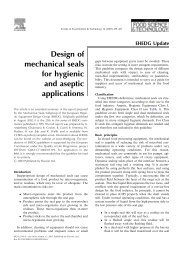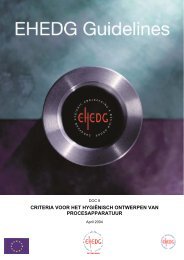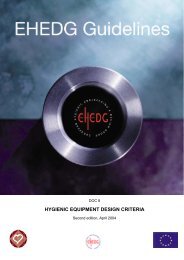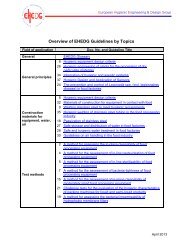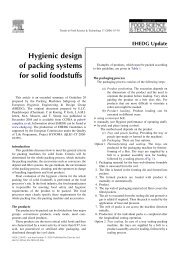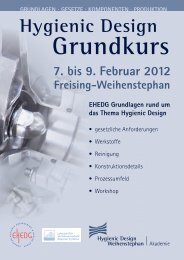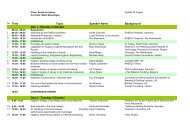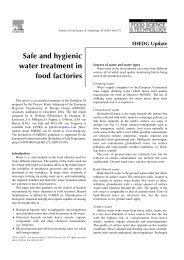Yearbook 2013/2014 - ehedg
Yearbook 2013/2014 - ehedg
Yearbook 2013/2014 - ehedg
You also want an ePaper? Increase the reach of your titles
YUMPU automatically turns print PDFs into web optimized ePapers that Google loves.
158 EHEDG Guidelines<br />
Doc. 23. Production and use of food-grade<br />
lubricants, Part 1 and 2<br />
Second edition, May 2009 (Part 1: Use of H1<br />
Registered Lubricants - 23 Pages / Part 2: Production<br />
of H1 Registered Lubricants - 10 Pages)<br />
Lubricants, grease and oil are necessary components<br />
for the lubrication, heat transfer, power transmission<br />
and corrosion protection of machinery, machine parts,<br />
instruments and equipment. Incidental contact between<br />
lubricants and food cannot always be fully excluded and<br />
may result in contamination of the food product. This risk<br />
applies to all lubricants equally. PART 1 of this guideline<br />
covers the hazards that may occur when using food grade<br />
lubricants and describes the actions and activities required<br />
to eliminate them or to reduce their impact or occurrence<br />
to an acceptable level. PART 2 of this guideline lays<br />
down the general requirements and recommendations<br />
for the hygienic manufacturing and supply of food-safe<br />
lubricants.<br />
Training DVD available.<br />
Languages available: Dutch, English, French,<br />
German, Japanese, Macedonian, Spanish<br />
Doc. 24. The prevention and control of<br />
legionella spp (incl. legionnaires’ disease)<br />
in food factories<br />
First edition, August 2002 (21 pages)<br />
There are many locations in food industry sites where the<br />
potential for the proliferation of Legionella spp in water<br />
systems exists. These bacteria can give rise to a potentially<br />
fatal disease in humans, which is identified as legionellosis<br />
or legionnaires’ disease.<br />
This document applies to the control of Legionella spp. in<br />
any undertaking involving a work activity and to premises<br />
controlled in connection with a trade, business or other<br />
undertaking where water is used or stored and where there<br />
is a means of transmitting water droplets which may be<br />
inhaled, thereby causing a reasonably foreseeable risk of<br />
exposure to Legionella spp.<br />
The guidelines summarises the best practice for controlling<br />
Legionella in water systems. It consists of two parts; namely,<br />
Management Practices and Guidance on the Control of<br />
Legionella spp. in Water Systems.<br />
The first section describes a management programme:<br />
risk identification and assessment; risk management (incl<br />
personnel responsibilities); preventing or controlling risk of<br />
exposure to the bacteria; and record keeping.<br />
The second part provides guidance on the design and<br />
construction of hot and cold water systems as well as the<br />
management and monitoring of these systems. Water<br />
treatment programmes, with attention to cleaning and<br />
disinfection, are also discussed.<br />
Languages available:<br />
Dutch, English, Macedonian<br />
Doc. 25. Design of mechanical seals for<br />
hygienic and aseptic applications<br />
First edition, August 2002 (15 pages) –<br />
update in progress since 2012<br />
This guideline compares the design aspects of different<br />
mechanical seals with respect to ease of cleaning, microbial<br />
impermeability, sterilisability or pasteurisability. It can<br />
serve as a guide for suppliers and users of this important<br />
component. Using EHEDG definitions, mechanical seals<br />
are classified according to use in the food industry into<br />
three categories: Aseptic, Hygienic equipment Class I,<br />
and Hygienic Equipment Class II. Both single and dual<br />
mechanical seals fall under the first two categories, which by<br />
definition, are subject to more stringent hygienic demands.<br />
General design criteria and basic material requirements for<br />
food applications are explained. Materials covered include<br />
carbon-graphite, ceramics, elastomers and metals. Hygienic<br />
implications of seal elements and components are also<br />
discussed. Finally, installation requirements are described<br />
and illustrated, taking into account the product environment<br />
side, the flushing side and the cartridge design.<br />
Languages available:<br />
Armenian, English, German<br />
Doc. 26. Hygienic engineering of plants for<br />
the processing of dry particulate materials<br />
First edition, November 2003 (30 pages)<br />
This document describes general engineering guidelines<br />
to be applied to ensure that buildings, individual equipment<br />
items and accessibility of equipment when integrated within<br />
the plant layout are designed so that aspects of the process<br />
operation, cleaning and maintenance comply with hygienic<br />
design standards. It details requirements related to plant<br />
enclosure, including hygienic zoning, building structures<br />
and ele¬ments (from floor to ceiling) as well as process line<br />
installation. Attention is also given to air stream and water<br />
related aspects within the plant as well as cleaning and<br />
contamination aspects. See also Doc. 22.<br />
Languages available:<br />
Dutch, English, French, Macedonian, Spanish<br />
Doc. 27. Safe storage and distribution of<br />
water in food factories<br />
First edition, April 2004 (16 pages)<br />
Water is a vital medium used for many different purposes in<br />
the food industry. Systems for storing and distributing water<br />
can involve hazards, which could cause water quality to fall<br />
below acceptable standards. It is therefore critical to ensure<br />
that water storage and distribution in a food manufacturing<br />
operation takes place in a controlled, safe way. This Guideline<br />
summarizes the best practice for three water categories<br />
used in the food industry: product water, domestic water and<br />
utility water. See also Doc. 24.<br />
Languages available:<br />
Armenian, Dutch, English, French, Macedonian,<br />
Spanish



